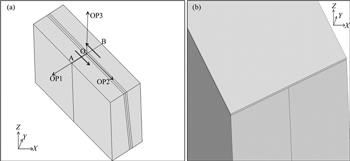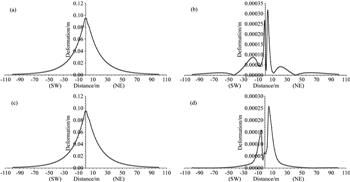| 引用本文: | 李红, 邓志辉, 陈连旺, 周庆, 冉洪流, 邢成起. 2019. 走滑断层地震地表破裂带分布影响因素数值模拟研究——以1973年炉霍MS7.6地震为例. 地球物理学报, 62(8): 2871-2884, doi: 10.6038/cjg2019M0240 |
| 摘 要: | 
地震后在断层两侧的强变形与破裂带是地震灾害最严重的区域.为系统、定量研究同震地表变形带特征及其影响因素,本研究建立了走滑断层的三维有限元模型,分别探讨了断层位错量、断层倾角、错动方式、上覆松散层厚度、沉积层土性等因素的影响规律.
模拟结果显示:走滑断层同震地表变形表现为以断层为中心的近似对称单峰分布,强地表变形集中在断层两侧各50 m宽度范围,地表变形量峰值随位错量增加而增大,破裂带宽度也随位错量增加而增大,但增量逐渐减小,并趋于一个渐近值;断层倾角对地表变形与破裂带宽度影响表现为随倾角减小变形量峰值点向上盘小距离偏移;走滑兼正断位错引起的变形量峰值最大,但地表破裂带宽度最小,走滑兼逆断引起的变形量峰值最小,但地表破裂带宽度最大,直立纯走滑断层的两参量都居中;走滑断层地表变形量峰值随上覆松散层厚度增大而减小,但随厚度减小的速率逐渐变小,松散层厚度从5 m增加到20 m时,破裂带宽度随厚度增加而缓慢增加,但自厚度大于20 m时,破裂带宽度开始随厚度增加而逐渐下降;当不同土性覆盖层(粗砂、粉砂、黏土)厚度相同时,地震引起的地表变形量峰值自粗砂、粉砂、黏土逐次增大,当粗砂厚度为60 m以上时,3.6 m的同震水平位错已不能形成地表破裂,而粉砂的厚度为70 m以上,黏土的厚度则为75 m以上.

|



